Do you have a question about the Panasonic minas a series and is the answer not in the manual?
Indicates a hazardous situation, potentially leading to death or serious injury.
Indicates a hazardous situation, potentially leading to minor injury or physical damage.
Instructions for checking the product after unpacking.
Steps to verify the driver model from the nameplate.
Steps to verify the motor model from its nameplate.
How to ensure driver and motor compatibility.
Description of the driver's components and connections.
Description of the motor's components and connections.
Location and environmental conditions for amplifier installation.
Specifies ambient temperature, humidity, and vibration limits for installation.
Instructions for vertical placement and mounting configurations.
Specifies cooling space and fan placement for drivers.
Guidelines for managing cable stress and bending radius.
Information on radial and thrust loads on the motor shaft.
Overview of NFB, NF, MC, and Reactor in the main power circuit.
Details on NFB, NF, MC, Reactor, and regenerative discharge resistor connections.
Connectors for PC or controller communication.
Connector for controller communication.
Connector for encoder connection.
Table listing available amplifier, NFB, noise filter, and contactor components.
Wiring instructions and precautions for main circuits.
Diagrams for 3-phase and 1-phase connections.
Wiring instructions for encoder connection.
Wiring diagrams for incremental encoders.
Wiring diagram for absolute/incremental encoders.
Using connectors for RS232C or RS485 communication.
Wiring instructions for controller connection.
CN I/F wiring for position control.
CN I/F wiring for velocity control.
CN I/F wiring for torque control.
Input Signals (Common) and their Functions.
Details on command pulse, sign, and scalar switch inputs.
Details on counter clear, command pulse inhibit, and speed zero clamp inputs.
Details on gain switching and alarm clear inputs.
Details on servo alarm, ready, brake release, and zero speed detection outputs.
Details on torque limit and in-position/at-speed outputs.
Details on encoder phase signals and monitor outputs.
Interface Circuit (Input Circuit) for SI and PI signals.
Interface Circuit (Input Circuit) for AI signals.
Interface Circuit (Output Circuit) for SO1, SO2, PO, and AO signals.
Introduction to the driver's parameters for setting features and functions.
Categorization of parameters by function group.
Parameters for function selection including control mode and baud rate.
Parameters for adjusting gain filters, loop gains, and time constants.
Parameters for real-time auto gain tuning.
Parameters for adjusting the 2nd gain settings.
Parameters related to position control settings.
Parameters for velocity and torque control settings.
Parameters for sequence control, including in-position and zero-speed settings.
How to set parameters using the front panel or PANATERM.
Structure of the driver's modes (Monitor, Parameter Setting, EEPROM, etc.).
Step-by-step guide for using the front touch panel to set parameters.
Pre-run checks for wiring, power, motor security, and load.
Procedure for performing a trial run using the JOG function.
How to run the driver with CN I/F connected.
Procedure for running the driver in position control mode.
Procedure for running the driver in velocity control mode.
Why gain adjustment is necessary for servo motors.
Overview of automatic and manual gain adjustment types.
Conditions and parameters for automatic gain tuning.
How gain affects mechanical stiffness and vice versa.
Flowchart for adjusting servo motor gains.
Step-by-step guide for normal auto gain tuning.
Guide for using real-time auto-gain tuning.
Process for manually adjusting servo motor gains.
Steps for adjusting gains in position control mode.
Steps for adjusting gains in velocity control mode.
Methods to improve system response using 2nd gain adjustments.
Using filters to reduce mechanical resonance.
Overview of the driver's protective functions.
Table listing protective functions, causes, and countermeasures.
Cause and countermeasures for encoder A/B phase errors.
Cause and countermeasures for position errors.
Cause and countermeasures for hybrid errors.
Cause and countermeasures for over-speed conditions.
Cause and countermeasures for command pulse sealer errors.
Cause and countermeasures for external scale errors.
Cause and countermeasures for error counter overflow.
Cause and countermeasures for overtravel inhibit issues.
Cause and countermeasures for absolute system down errors.
Cause and countermeasures for absolute encoder counter overflow.
Cause and countermeasures for absolute encoder overspeed errors.
Important notes for personnel performing maintenance.
Daily and periodical inspection items and their cycles.
Guidance on parts replacement cycles and prohibited actions.
Troubleshooting steps when the motor does not rotate.
Causes and countermeasures for motor not rotating, categorized by parameters, wiring, and installation.
Troubleshooting steps for uneven motor rotation.
Troubleshooting steps when positioning accuracy is poor.
Causes and countermeasures for poor positioning accuracy related to wiring.
Troubleshooting steps when the initial home position varies.
Causes and countermeasures for abnormal motor sound or vibration.
Troubleshooting steps for overshoot or undershoot issues.
Causes and countermeasures for motor overheating.
Troubleshooting steps when motor speed is insufficient.
Causes and countermeasures for parameter value changes.
Troubleshooting PANATERM communication detection errors.
Information on EC Directives and CE Marking requirements.
Compliance with EMC Directives and applicable standards.
Requirements for the operating environment and control box.
Recommendation for installing a circuit breaker.
Recommendation for installing noise filters.
Recommendation for installing a surge absorber.
Table of peripheral devices applicable to drivers, including noise filters and surge absorbers.
Important notes and cautions regarding brake usage.
Example circuit for controlling the brake using the BRK-OFF signal.
Details on the timing and function of the BRK-OFF signal.
Settings for dynamic brake operation when main power is off.
Settings for dynamic brake operation when Servo-OFF is active.
Settings for dynamic brake operation during protective functions.
Settings for dynamic brake operation during over-travel inhibit.
Timing chart showing events after power ON and Servo-ON signal reception.
Timing chart showing events after an alarm during Servo-ON.
Timing chart for events after an alarm is cleared.
Timing chart for Servo-ON/OFF operation when the motor is stopped.
Timing chart for Servo-ON/OFF operation when the motor is running.
Procedure to clear and initialize the encoder.
Explanation of single-turn and multi-turn absolute data.
Details on the 15-character hexadecimal binary code structure.
Explanation of encoder status bits and error codes.
Methods for connecting the backup battery for absolute encoders.
Protocol details for RS232C communication.
Flowchart for RS232C command transfer.
Details on RS485 connection and communication.
Flowchart for RS485 communication.
Step-by-step instructions for installing the battery.
Instructions for installing the battery for different driver types.
Wiring instructions for the main circuit of full-close drivers.
CN SIG connector wiring for full-close system.
Details on connecting the CN I/F connector to an external scale.
Diagrams showing signal relationships for CCW and CW rotation.
Parameters for axis address and initial LED status display.
Parameters for control mode set-up and analogue torque limit inhibit.
Function and operation of overtravel input inhibit.
Parameters for selecting internal speed settings.
Example of 4-speed operation using internal velocity commands.
Function of ZEROSPD input.
Relationship between output voltage and motor speed.
Relationship between output voltage and motor torque/position error.
Functions of the torque limit output.
Defines functions of zero speed detection output.
Settings for using absolute encoders.
Sets the baud rate for RS232C communication.
Sets the baud rate for RS485 communication.
Parameters for auto tuning related to gains and filters.
Parameters for 2nd gain, notch filter, and disturbance torque observer.
Parameters for inertia ratio, real-time auto tuning, and machine stiffness.
Parameters for 2nd gain action and position control switching mode.
Parameters for position control switching delay, level, hysteresis, and gain switching time.
Parameters for switching between 1st and 2nd gains in velocity control.
Parameters for velocity control switching delay, level, and hysteresis.
Parameters for switching between 1st and 2nd gains in torque control.
Parameters for command pulse multiplier and logic inversion.
Setting the type of command pulse to the driver.
Maximum permissible frequency and minimum time width of pulse inputs.
Enabling or disabling command pulse inhibit input.
Setting encoder pulse counts per single turn.
Pulse command scaling function for motor speed and travel amount.
Selecting command scalar numerator and example calculations.
Setting up the smoothing filter for command pulse input.
Conditions for clearing the position error counter.
Parameters for velocity command input gain and logic inversion.
Parameters for velocity command offset and internal speed settings.
Parameters for acceleration/deceleration and S-shaped time settings.
Parameters for torque command input gain.
Parameters for torque command input inversion and torque limit set-up.
Parameters for in-position range and zero speed detection.
Parameters for at-speed signal and position error set-up.
Disabling position error limit protection.
Selects under-voltage trip activation on main power shut-off.
Sets conditions for dynamic brake after over-travel limit input.
Sets operations after main power off, including deceleration and error counter clearing.
Sets conditions for motor stop after protective functions activate.
Defines processes after Servo-OFF, including deceleration and error clearing.
Defines brake engagement duration after Servo-OFF.
Avoids brake degradation due to motor rotation.
Selects internal or external regenerative discharge resistor.
Operations within the Monitor mode, including selecting display modes.
Indication of position error, motor speed, and torque output.
Displays the current control mode of the driver.
Displays status of control input and output signals via CN I/F connectors.
Lists input and output signals with their numbers, symbols, pins, and descriptions.
How to view current and historical alarm codes.
Table of alarm codes and their corresponding functions.
Interpretation of alarm display codes and meanings.
Displays load factor for regenerative discharge resistor and overload.
How to operate in parameter setting mode using the front panel.
Overview of auxiliary functions like auto offset adjustment.
Procedure for automatic offset adjustment of analogue commands.
Overview of auxiliary functions like alarm clear mode.
Procedure for clearing alarms using the LED touch panel.
Overview of auxiliary functions like absolute encoder clear mode.
Procedure to clear multi-turn data and encoder alarms.
Steps for connecting PANATERM software to the driver.
Procedure for installing PANATERM software.
Steps to start the PANATERM software.
List of optional encoder, motor, and brake cables with part numbers.
Details and part numbers for various encoder cables.
Details and part numbers for motor cables.
Details and part numbers for motor cables with brake.
Details on connector kits for CN I/F, including pin alignment.
Connector kits for motor and encoder connections.
Connector kits for motor and encoder connections (different part numbers).
Pin alignment for CN SIG connectors for 2500P/R and 17-bit encoders.
Details and wire table for interface cables.
Part numbers and lengths for PC communication cables.
Part numbers and lengths for RS485 communication cables.
Part number for PANATERM software.
Details on mounting brackets for drivers.
Part numbers for batteries and holders for absolute encoders.
Outer dimensions for absolute drivers with batteries.
Recommended surge absorbers for motor brakes.
Dimensions for MSMA series motors (30W-750W).
Dimensions for MSMA series motors with different shaft types.
Dimensions for MSMA series motors (1.0kW-5.0kW).
Dimensions for MSMA series motors with different shaft types and brake options.
Dimensions for MQMA series motors (100W-400W).
Dimensions for MQMA series motors with different shaft types and brake options.
Dimensions for MDMA series motors (750W-5.0kW).
Dimensions for MDMA series motors with different shaft types and brake options.
Dimensions for MHMA series motors (500W-5.0kW).
Dimensions for MHMA series motors with different shaft types and brake options.
Dimensions for MFMA series motors (400W-4.5kW).
Dimensions for MFMA series motors with different shaft types and brake options.
Dimensions for MGMA series motors (300W-4.5kW).
Dimensions for MGMA series motors with different shaft types and brake options.
Outer dimensions and mounting details for Driver Type 1.
Outer dimensions and mounting details for Driver Type 2.
Outer dimensions and mounting details for Driver Type 3.
Outer dimensions and mounting details for Driver Type 4-2.
Outer dimensions and mounting details for Driver Type 4-3.
Outer dimensions and mounting details for Driver Type 5.
Graph showing overload protection time limiting characteristics.
Conditions for gain switching in Position, Velocity, and Torque control modes.
Figures illustrating gain switching timing and hysteresis.
Block diagram of the driver's internal circuits for types 1, 2, and 3.
Block diagram of the driver's internal circuits for types 4-2 and 4-3.
Block diagram of the driver's internal circuits for type 5.
Detailed control block diagram of the driver.
Summary of driver specifications including power, control system, encoder, functions, monitor, and settings.
Indicates a hazardous situation, potentially leading to death or serious injury.
Indicates a hazardous situation, potentially leading to minor injury or physical damage.
Instructions for checking the product after unpacking.
Steps to verify the driver model from the nameplate.
Steps to verify the motor model from its nameplate.
How to ensure driver and motor compatibility.
Description of the driver's components and connections.
Description of the motor's components and connections.
Location and environmental conditions for amplifier installation.
Specifies ambient temperature, humidity, and vibration limits for installation.
Instructions for vertical placement and mounting configurations.
Specifies cooling space and fan placement for drivers.
Guidelines for managing cable stress and bending radius.
Information on radial and thrust loads on the motor shaft.
Overview of NFB, NF, MC, and Reactor in the main power circuit.
Details on NFB, NF, MC, Reactor, and regenerative discharge resistor connections.
Connectors for PC or controller communication.
Connector for controller communication.
Connector for encoder connection.
Table listing available amplifier, NFB, noise filter, and contactor components.
Wiring instructions and precautions for main circuits.
Diagrams for 3-phase and 1-phase connections.
Wiring instructions for encoder connection.
Wiring diagrams for incremental encoders.
Wiring diagram for absolute/incremental encoders.
Using connectors for RS232C or RS485 communication.
Wiring instructions for controller connection.
CN I/F wiring for position control.
CN I/F wiring for velocity control.
CN I/F wiring for torque control.
Input Signals (Common) and their Functions.
Details on command pulse, sign, and scalar switch inputs.
Details on counter clear, command pulse inhibit, and speed zero clamp inputs.
Details on gain switching and alarm clear inputs.
Details on servo alarm, ready, brake release, and zero speed detection outputs.
Details on torque limit and in-position/at-speed outputs.
Details on encoder phase signals and monitor outputs.
Interface Circuit (Input Circuit) for SI and PI signals.
Interface Circuit (Input Circuit) for AI signals.
Interface Circuit (Output Circuit) for SO1, SO2, PO, and AO signals.
Introduction to the driver's parameters for setting features and functions.
Categorization of parameters by function group.
Parameters for function selection including control mode and baud rate.
Parameters for adjusting gain filters, loop gains, and time constants.
Parameters for real-time auto gain tuning.
Parameters for adjusting the 2nd gain settings.
Parameters related to position control settings.
Parameters for velocity and torque control settings.
Parameters for sequence control, including in-position and zero-speed settings.
How to set parameters using the front panel or PANATERM.
Structure of the driver's modes (Monitor, Parameter Setting, EEPROM, etc.).
Step-by-step guide for using the front touch panel to set parameters.
Pre-run checks for wiring, power, motor security, and load.
Procedure for performing a trial run using the JOG function.
How to run the driver with CN I/F connected.
Procedure for running the driver in position control mode.
Procedure for running the driver in velocity control mode.
Why gain adjustment is necessary for servo motors.
Overview of automatic and manual gain adjustment types.
Conditions and parameters for automatic gain tuning.
How gain affects mechanical stiffness and vice versa.
Flowchart for adjusting servo motor gains.
Step-by-step guide for normal auto gain tuning.
Guide for using real-time auto-gain tuning.
Process for manually adjusting servo motor gains.
Steps for adjusting gains in position control mode.
Steps for adjusting gains in velocity control mode.
Methods to improve system response using 2nd gain adjustments.
Using filters to reduce mechanical resonance.
Overview of the driver's protective functions.
Table listing protective functions, causes, and countermeasures.
Cause and countermeasures for encoder A/B phase errors.
Cause and countermeasures for position errors.
Cause and countermeasures for hybrid errors.
Cause and countermeasures for over-speed conditions.
Cause and countermeasures for command pulse sealer errors.
Cause and countermeasures for external scale errors.
Cause and countermeasures for error counter overflow.
Cause and countermeasures for overtravel inhibit issues.
Cause and countermeasures for absolute system down errors.
Cause and countermeasures for absolute encoder counter overflow.
Cause and countermeasures for absolute encoder overspeed errors.
Important notes for personnel performing maintenance.
Daily and periodical inspection items and their cycles.
Guidance on parts replacement cycles and prohibited actions.
Troubleshooting steps when the motor does not rotate.
Causes and countermeasures for motor not rotating, categorized by parameters, wiring, and installation.
Troubleshooting steps for uneven motor rotation.
Troubleshooting steps when positioning accuracy is poor.
Causes and countermeasures for poor positioning accuracy related to wiring.
Troubleshooting steps when the initial home position varies.
Causes and countermeasures for abnormal motor sound or vibration.
Troubleshooting steps for overshoot or undershoot issues.
Causes and countermeasures for motor overheating.
Troubleshooting steps when motor speed is insufficient.
Causes and countermeasures for parameter value changes.
Troubleshooting PANATERM communication detection errors.
Information on EC Directives and CE Marking requirements.
Compliance with EMC Directives and applicable standards.
Requirements for the operating environment and control box.
Recommendation for installing a circuit breaker.
Recommendation for installing noise filters.
Recommendation for installing a surge absorber.
Table of peripheral devices applicable to drivers, including noise filters and surge absorbers.
Important notes and cautions regarding brake usage.
Example circuit for controlling the brake using the BRK-OFF signal.
Details on the timing and function of the BRK-OFF signal.
Settings for dynamic brake operation when main power is off.
Settings for dynamic brake operation when Servo-OFF is active.
Settings for dynamic brake operation during protective functions.
Settings for dynamic brake operation during over-travel inhibit.
Timing chart showing events after power ON and Servo-ON signal reception.
Timing chart showing events after an alarm during Servo-ON.
Timing chart for events after an alarm is cleared.
Timing chart for Servo-ON/OFF operation when the motor is stopped.
Timing chart for Servo-ON/OFF operation when the motor is running.
Procedure to clear and initialize the encoder.
Explanation of single-turn and multi-turn absolute data.
Details on the 15-character hexadecimal binary code structure.
Explanation of encoder status bits and error codes.
Methods for connecting the backup battery for absolute encoders.
Protocol details for RS232C communication.
Flowchart for RS232C command transfer.
Details on RS485 connection and communication.
Flowchart for RS485 communication.
Step-by-step instructions for installing the battery.
Instructions for installing the battery for different driver types.
Wiring instructions for the main circuit of full-close drivers.
CN SIG connector wiring for full-close system.
Details on connecting the CN I/F connector to an external scale.
Diagrams showing signal relationships for CCW and CW rotation.
Parameters for axis address and initial LED status display.
Parameters for control mode set-up and analogue torque limit inhibit.
Function and operation of overtravel input inhibit.
Parameters for selecting internal speed settings.
Example of 4-speed operation using internal velocity commands.
Function of ZEROSPD input.
Relationship between output voltage and motor speed.
Relationship between output voltage and motor torque/position error.
Functions of the torque limit output.
Defines functions of zero speed detection output.
Settings for using absolute encoders.
Sets the baud rate for RS232C communication.
Sets the baud rate for RS485 communication.
Parameters for auto tuning related to gains and filters.
Parameters for 2nd gain, notch filter, and disturbance torque observer.
Parameters for inertia ratio, real-time auto tuning, and machine stiffness.
Parameters for 2nd gain action and position control switching mode.
Parameters for position control switching delay, level, hysteresis, and gain switching time.
Parameters for switching between 1st and 2nd gains in velocity control.
Parameters for velocity control switching delay, level, and hysteresis.
Parameters for switching between 1st and 2nd gains in torque control.
Parameters for command pulse multiplier and logic inversion.
Setting the type of command pulse to the driver.
Maximum permissible frequency and minimum time width of pulse inputs.
Enabling or disabling command pulse inhibit input.
Setting encoder pulse counts per single turn.
Pulse command scaling function for motor speed and travel amount.
Selecting command scalar numerator and example calculations.
Setting up the smoothing filter for command pulse input.
Conditions for clearing the position error counter.
Parameters for velocity command input gain and logic inversion.
Parameters for velocity command offset and internal speed settings.
Parameters for acceleration/deceleration and S-shaped time settings.
Parameters for torque command input gain.
Parameters for torque command input inversion and torque limit set-up.
Parameters for in-position range and zero speed detection.
Parameters for at-speed signal and position error set-up.
Disabling position error limit protection.
Selects under-voltage trip activation on main power shut-off.
Sets conditions for dynamic brake after over-travel limit input.
Sets operations after main power off, including deceleration and error counter clearing.
Sets conditions for motor stop after protective functions activate.
Defines processes after Servo-OFF, including deceleration and error clearing.
Defines brake engagement duration after Servo-OFF.
Avoids brake degradation due to motor rotation.
Selects internal or external regenerative discharge resistor.
Operations within the Monitor mode, including selecting display modes.
Indication of position error, motor speed, and torque output.
Displays the current control mode of the driver.
Displays status of control input and output signals via CN I/F connectors.
Lists input and output signals with their numbers, symbols, pins, and descriptions.
How to view current and historical alarm codes.
Table of alarm codes and their corresponding functions.
Interpretation of alarm display codes and meanings.
Displays load factor for regenerative discharge resistor and overload.
How to operate in parameter setting mode using the front panel.
Overview of auxiliary functions like auto offset adjustment.
Procedure for automatic offset adjustment of analogue commands.
Overview of auxiliary functions like alarm clear mode.
Procedure for clearing alarms using the LED touch panel.
Overview of auxiliary functions like absolute encoder clear mode.
Procedure to clear multi-turn data and encoder alarms.
Steps for connecting PANATERM software to the driver.
Procedure for installing PANATERM software.
Steps to start the PANATERM software.
List of optional encoder, motor, and brake cables with part numbers.
Details and part numbers for various encoder cables.
Details and part numbers for motor cables.
Details and part numbers for motor cables with brake.
Details on connector kits for CN I/F, including pin alignment.
Connector kits for motor and encoder connections.
Connector kits for motor and encoder connections (different part numbers).
Pin alignment for CN SIG connectors for 2500P/R and 17-bit encoders.
Details and wire table for interface cables.
Part numbers and lengths for PC communication cables.
Part numbers and lengths for RS485 communication cables.
Part number for PANATERM software.
Details on mounting brackets for drivers.
Part numbers for batteries and holders for absolute encoders.
Outer dimensions for absolute drivers with batteries.
Recommended surge absorbers for motor brakes.
Dimensions for MSMA series motors (30W-750W).
Dimensions for MSMA series motors with different shaft types.
Dimensions for MSMA series motors (1.0kW-5.0kW).
Dimensions for MSMA series motors with different shaft types and brake options.
Dimensions for MQMA series motors (100W-400W).
Dimensions for MQMA series motors with different shaft types and brake options.
Dimensions for MDMA series motors (750W-5.0kW).
Dimensions for MDMA series motors with different shaft types and brake options.
Dimensions for MHMA series motors (500W-5.0kW).
Dimensions for MHMA series motors with different shaft types and brake options.
Dimensions for MFMA series motors (400W-4.5kW).
Dimensions for MFMA series motors with different shaft types and brake options.
Dimensions for MGMA series motors (300W-4.5kW).
Dimensions for MGMA series motors with different shaft types and brake options.
Outer dimensions and mounting details for Driver Type 1.
Outer dimensions and mounting details for Driver Type 2.
Outer dimensions and mounting details for Driver Type 3.
Outer dimensions and mounting details for Driver Type 4-2.
Outer dimensions and mounting details for Driver Type 4-3.
Outer dimensions and mounting details for Driver Type 5.
Graph showing overload protection time limiting characteristics.
Conditions for gain switching in Position, Velocity, and Torque control modes.
Figures illustrating gain switching timing and hysteresis.
Block diagram of the driver's internal circuits for types 1, 2, and 3.
Block diagram of the driver's internal circuits for types 4-2 and 4-3.
Block diagram of the driver's internal circuits for type 5.
Detailed control block diagram of the driver.
Summary of driver specifications including power, control system, encoder, functions, monitor, and settings.
| Brand | Panasonic |
|---|---|
| Model | minas a series |
| Category | Servo Drives |
| Language | English |
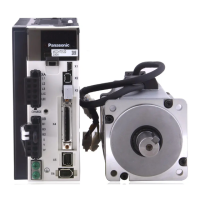
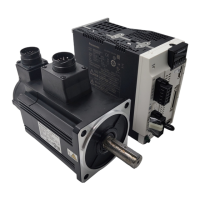
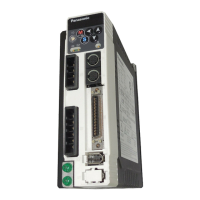
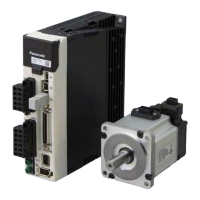

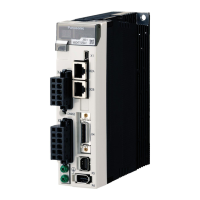

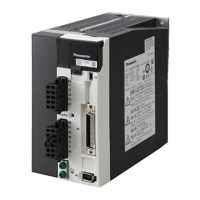


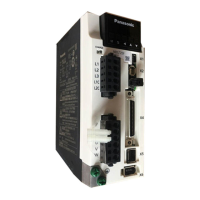

